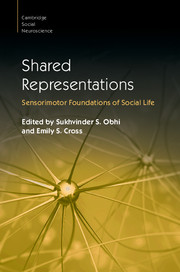Book contents
- Shared Representations
- Cambridge Social Neuroscience
- Shared Representations
- Copyright page
- Contents
- Figures
- Tables
- Boxes
- Contributors
- Preface
- Part I Foundations
- Part II Imitation and Mimicry
- 6 The Comparative Study of Imitation Mechanisms in Non-Human Primates
- 7 The Cultural Transmission of Social Information
- 8 The Control of Shared Representations and Social Cognition
- 9 Neurocognitive Explorations of Social Mimicry
- Part III Thinking, Perceiving and Acting with Others
- Part IV Understanding Others
- Part V Learning and Development
- Part VI Shared Representations in Applied Contexts
- Index
- Plate Section (PDF Only)
- References
8 - The Control of Shared Representations and Social Cognition
from Part II - Imitation and Mimicry
Published online by Cambridge University Press: 27 October 2016
- Shared Representations
- Cambridge Social Neuroscience
- Shared Representations
- Copyright page
- Contents
- Figures
- Tables
- Boxes
- Contributors
- Preface
- Part I Foundations
- Part II Imitation and Mimicry
- 6 The Comparative Study of Imitation Mechanisms in Non-Human Primates
- 7 The Cultural Transmission of Social Information
- 8 The Control of Shared Representations and Social Cognition
- 9 Neurocognitive Explorations of Social Mimicry
- Part III Thinking, Perceiving and Acting with Others
- Part IV Understanding Others
- Part V Learning and Development
- Part VI Shared Representations in Applied Contexts
- Index
- Plate Section (PDF Only)
- References
Summary
Evidence from cognitive psychology and neuroscience has been accumulated suggesting that perception and execution of action are tightly linked. The observation of an action leads to a direct activation of the corresponding motor representation in the observer, suggesting that perception and action rely on a ‘shared representational system’. Moreover, the observation of an action can lead to automatic imitation. However, if perception and action can lead to the concurrent activation of different motor plans, a fundamental problem is how we are able to distinguish between motor representations that have been internally generated by our own intention and those that have been triggered by observing others’ actions. In other words, how can we avoid automatic imitation? In the present chapter, we will report recent evidence suggesting that a crucial component of such shared representation systems is self–other distinction and that the control of shared representations involves brain areas that constitute key nodes in high-level socio-cognitive processes such as agency attribution, perspective taking and mentalizing.
- Type
- Chapter
- Information
- Shared RepresentationsSensorimotor Foundations of Social Life, pp. 151 - 170Publisher: Cambridge University PressPrint publication year: 2016
References
- 1
- Cited by



